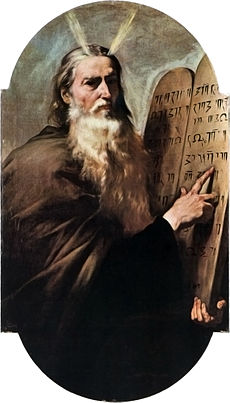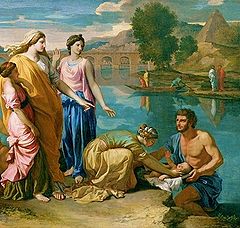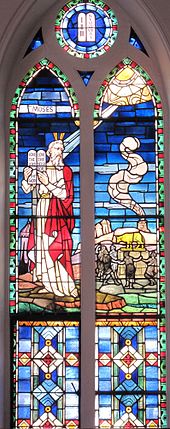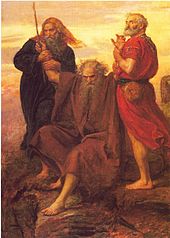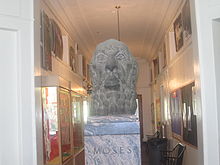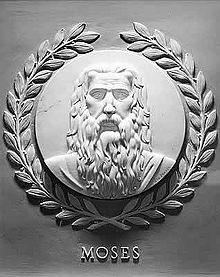- Moses
-
For other uses, see Moses (disambiguation).
Moses 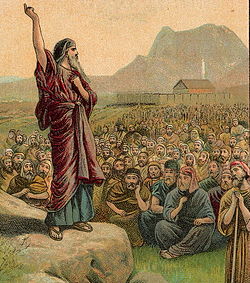
Moses pleading with the Children of Israel, lithography from a Bible card published in 1907Prophet, Lawgiver, Hebrew Patriarch Born Goshen, Lower Egypt Died Mount Nebo, Moab Honored in Judaism
Christianity
IslamInfluenced Many
Jews, Christians and Muslims
Moses (Hebrew: מֹשֶׁה, Modern Moshe Tiberian Mōšéh ISO 259-3 Moše; Greek: Mωϋσῆς Mōüsēs; Arabic: موسىٰ Mūsa) was, according to the Hebrew Bible and Qur'an, a religious leader, lawgiver and prophet, to whom the authorship of the Torah is traditionally attributed. Also called Moshe Rabbenu in Hebrew (מֹשֶׁה רַבֵּנוּ, Lit. "Moses our Teacher/Rabbi"), he is the most important prophet in Judaism,[1][2] and is also considered an important prophet in Christianity and Islam, as well as a number of other faiths.The existence of Moses as well as the veracity of the Exodus story is disputed amongst archaeologists and Egyptologists, with experts in the field of biblical criticism citing logical inconsistencies, new archaeological evidence, historical evidence, and related origin myths in Canaanite culture.[3][4][5] Other historians maintain that the biographical details, and Egyptian background, attributed to Moses imply the existence of a historical political and religious leader who was involved in the consolidation of the Hebrew tribes in Canaan towards the end of the Bronze Age.
According to the Book of Exodus, Moses was born in a time when his people, the Children of Israel, were increasing in number and the Egyptian Pharaoh was worried that they might help Egypt's enemies. Moses' Hebrew mother, Jochebed, hides him when the Pharaoh ordered all newborn Hebrew boys to be killed, and the child is adopted as a foundling by the Egyptian royal family. After killing an Egyptian slave-master, Moses flees across the Red Sea to Midian where he has his encounter with the God of Israel in the form of the "burning bush". God sends Moses to request the release of the Israelites. After the Ten Plagues, Moses leads the Exodus of the Israelites out of Egypt and across the Red Sea, after which they base themselves at Mount Sinai, where Moses receives the Ten Commandments. After 40 years of wandering in the desert, Moses dies aged 120, within sight of the Promised Land.
Rabbinical Judaism calculated a lifespan of Moses corresponding to 1391–1271 BCE;[6] Christian tradition has tended to assume an earlier date.[7]
Contents
Name
The biblical text explains the name Mošeh משה as a derivation of the root mšh משה "to draw", in Exodus 2:10:
- "[...] she called his name Moses (משה): and she said, Because I drew him (משיתהו) out of the water." (KJV).[8]
The name is thus suggested to relate to drawing out in a passive sense, "the one who was drawn out". Those who depart from this tradition derive the name from the same root but in an active sense, "he who draws out", in the sense of "saviour, deliverer".[9] The form of the name as recorded in the Masoretic text is indeed the expected form of the Biblical Hebrew active participle.[10] Josephus argued for an Egyptian etymology, and some scholarly suggestions have followed this in deriving the name from Coptic terms mo "water" and `uses "save, deliver", suggesting a meaning "saved from the water".[11]
Another suggestion has connected the name with the Egyptian ms, as found in Tuth-mose and Ra-messes, meaning "born" or "child".[8][12]
Biblical narrative
Moses rescued from the Nile, 1638, by Nicolas Poussin
In the Hebrew Bible, the narratives of Moses are in Exodus, Leviticus, Numbers and Deuteronomy. According to the Book of Exodus, Moses was a son of Amram, a member of the Levite tribe of Israel descended from Jacob, and his wife, Jochebed.[13] Jochebed (also Yocheved) was kin to Amram's father Kehath (Exodus 6:20). Moses had one older (by seven years) sister, Miriam, and one older (by three years) brother, Aaron.[13] According to Genesis 46:11, Amram's father Kehath immigrated to Egypt with 70 of Jacob's household, making Moses part of the second generation of Israelites born during their time in Egypt.[14]
In the Exodus account, the birth of Moses occurred at a time when an unnamed Egyptian Pharaoh had commanded that all male Hebrew children born be killed by drowning in the river Nile. Jochebed, the wife of the Levite Amram, bore a son and kept him concealed for three months.[13][15][16] When she could keep him hidden no longer, rather than deliver him to be killed, she set him adrift on the Nile River in a small craft of bulrushes coated in pitch.[15] Moses' sister Miriam observed the progress of the tiny boat until it reached a place where Pharaoh's daughter (Bithiah,[13] Thermuthis [17]) was bathing with her handmaidens. It is said that she spotted the baby in the basket and had her handmaiden fetch it for her. Miriam came forward and asked Pharaoh's daughter if she would like a Hebrew woman to nurse the baby.[13] Thereafter, Jochebed was employed as the child's nurse. He grew up and was brought to Pharaoh's daughter and became her son and a younger brother to the future Pharaoh of Egypt. Moses would not be able to become Pharaoh because he was not the 'blood' son of Bithiah, and he was the youngest.[18][non-primary source needed]
Shepherd in Midian
After Moses had reached adulthood, he went to see how his brethren were faring.[15] Seeing an Egyptian beating a Hebrew, he killed the Egyptian and buried the body in the sand, supposing that no one who knew about the incident would be disposed to talk about it.[15] The next day, seeing two Hebrews quarreling, he endeavored to separate them, whereupon the Hebrew who was wronging the other taunted Moses for slaying the Egyptian.[19] Moses soon discovered from a higher source that the affair was known, and that Pharaoh was likely to put him to death for it; he therefore made his escape over the Sinai Peninsula.[15] In Midian he stopped at a well, where he protected seven shepherdesses from a band of rude shepherds. The shepherdesses' father Hobab adopted him as his son, gave his daughter Zipporah to him in marriage, and made him the superintendent of his herds.[15][20][21] There he sojourned forty years, following the occupation of a shepherd, during which time his son Gershom was born.[15][22] One day, Moses led his flock to Mount Horeb (Exodus 3), usually identified with Mount Sinai — a mountain that was thought in the Middle Ages to be located on the Sinai Peninsula. While tending the flocks of Jethro at Mount Horeb, he saw a burning bush. The bush was not consumed and when Moses turned aside to look more closely at the marvel, God spoke to him from the bush, revealing his name to Moses.[15]
Egypt: the Plagues and the Exodus
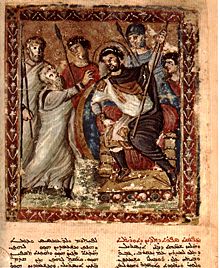 Moses before the Pharaoh, a 6th century miniature from the Syriac Bible of Paris.
Moses before the Pharaoh, a 6th century miniature from the Syriac Bible of Paris.
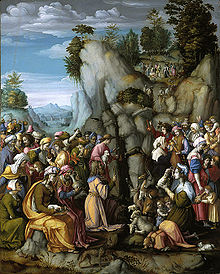 Moses strikes water from the stone, by Francesco Bacchiacca
Moses strikes water from the stone, by Francesco Bacchiacca
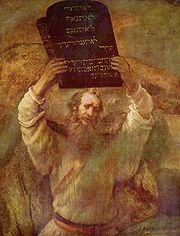 Moses with the tablets of the Ten Commandments, painting by Rembrandt (1659)
Moses with the tablets of the Ten Commandments, painting by Rembrandt (1659) Moses holding up his arms during the battle, assisted by Aaron and Hur. Painting by John Everett Millais
Moses holding up his arms during the battle, assisted by Aaron and Hur. Painting by John Everett Millais
God commanded Moses to go to Egypt and deliver his fellow Hebrews from bondage.[23] On the way Moses was nearly killed by God because his son was not circumcised. He was met on the way by his elder brother, Aaron, and gained a hearing with his oppressed kindred after they returned to Egypt, who believed Moses and Aaron after they saw the signs that were performed in the midst of the Israelite assembly.[24] Moses and Aaron went to Pharaoh and told him that the Lord God of Israel wanted Pharaoh to permit the Israelites to celebrate a feast in the wilderness. Pharaoh replied that he did not know their God and would not permit them to go. They gained a second hearing with Pharaoh and changed Moses' rod into a serpent, but Pharaoh's magicians did the same with their rods. Moses and Aaron met Pharaoh at the Nile riverbank, and Moses had Aaron turn the river to blood, but Pharaoh's magicians could do the same. Moses obtained a fourth meeting, and had Aaron bring frogs from the Nile to overrun Egypt, but Pharaoh's magicians were able to do the same thing. Pharaoh asked Moses to remove the frogs and promised to let the Israelites go observe their feast in the wilderness in return. Pharaoh decided against letting the Israelites leave to observe the feast.[25] Eventually Pharaoh let the Hebrews depart after Moses' God sent ten plagues upon the Egyptians. The third and fourth were the plague of gnats and flies. The fifth was diseases on the Egyptians' cattle, oxen, goats, sheep, camels, and horses. The sixth was boils on the skins of Egyptians. Seventh, fiery hail and thunder. The eighth plague was locusts. The ninth plague was total darkness. The tenth plague was the slaying of the Egyptian male first-born children, whereupon such terror seized the Egyptians that they ordered the Hebrews to leave. The events are commemorated as Passover, referring to how the plague "passed over" the houses of the Israelites while smiting the Egyptians.[26]
The crossing of the Red Sea
Main article: The ExodusMoses then led his people eastward, beginning the long journey to Canaan. The procession moved slowly, and found it necessary to encamp three times before passing the Egyptian frontier — some believe at the Great Bitter Lake, while others propose sites as far south as the northern tip of the Red Sea. Meanwhile, Pharaoh had a change of heart, and was in pursuit of them with a large army. Shut in between this army and the sea, the Israelites despaired, but Exodus records that God divided the waters so that they passed safely across on dry ground. There is some contention about this passage, since an earlier incorrect translation of Yam Suph to Red Sea was later found to have meant Reed Sea.[27] When the Egyptian army attempted to follow, God permitted the waters to return upon them and drown them.
The people then continued to Marsa marching for three days along the wilderness of the Shur [28] without finding water. Then they came to Elim where twelve water springs and 70 Palm trees greeted them.[29] From Elim they set out again and after 45 days they reached the wilderness of Sin between Elim and Sinai.
From there they reached the plain of Rephidim, completing the crossing of the Red Sea.
Mount Sinai and the Ten Commandments
Main article: Ten CommandmentsAccording to the Bible, after crossing the Red Sea and leading the Israelites towards the desert, Moses was summoned by God to Mount Sinai, also referred to as Mount Horeb, the same place where Moses had first talked to the Burning Bush, tended the flocks of Jethro his father-in-law, and later produced water by striking the rock with his staff and directed the battle with the Amalekites.
Moses stayed on the mountain for 40 days and nights, a period in which he received the Ten Commandments directly from God. Moses then descended from the mountain with intent to deliver the commandments to the people, but upon his arrival he saw that the people were involved in the sin of the Golden Calf. In terrible anger, Moses broke the commandment tablets[30] and ordered his own tribe (the Levites) to go through the camp and kill everyone, including family and friends,[31] upon which the Levites killed about 3,000 people.[32] God later commanded Moses to inscribe two other tablets, to replace the ones Moses smashed,[33] so Moses went to the mountain again, for another period of 40 days and nights, and when he returned, the commandments were finally given.
In Jewish tradition, Moses is referred to as "The Lawgiver" for this singular achievement of delivering the Ten Commandments.
The years in the wilderness
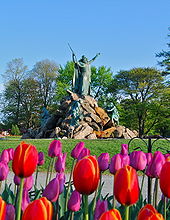 A statue of Moses smiting the rock stands in Washington Park, Albany, New York.
A statue of Moses smiting the rock stands in Washington Park, Albany, New York.
When the people arrived at Marah, the water was bitter, causing the people to murmur against Moses. Moses cast a tree into the water, and the water became sweet.[34][35] Later in the journey the people began running low on supplies and again murmured against Moses and Aaron and said they would have preferred to die in Egypt, but God's provision of manna from the sky in the morning and quail in the evening took care of the situation.[36][37] When the people camped in Rephidim, there was no water, so the people complained again and said, "Wherefore is this that thou hast brought us up out of Egypt, to kill us and our children and our cattle with thirst?" Moses struck a rock with his staff, and water came forth.[38][39]
Amalekites arrived and attacked the Israelites. In response, Moses bade Joshua lead the men to fight while he stood on a hill with the rod of God in his hand. As long as Moses held the rod up, Israel dominated the fighting, but if Moses let down his hands, the tide of the battle turned in favor of the Amalekites. Because Moses was getting tired, Aaron and Hur had Moses sit on a rock. Aaron held up one arm, Hur held up the other arm, and the Israelites routed the Amalekites.[40][41]
Jethro, Moses' father-in-law, came to see Moses and brought Moses' wife and two sons with him. After Moses had told Jethro how the Israelites had escaped Egypt, Jethro went to offer sacrifices to the Lord, and then ate bread with the elders. The next day Jethro observed how Moses sat from morning to night giving judgement for the people. Jethro suggested that Moses appoint judges for lesser matters, a suggestion Moses heeded.[42]
When the Israelites came to Sinai, they pitched camp near the mountain. Moses commanded the people not to touch the mountain. Moses received the Ten Commandments orally (but not yet in tablet form) and other moral laws. He then went up with Aaron, Nadab, Abihu, and seventy of the elders to see the God of Israel. Before Moses went up the mountain to receive the tablets, he told the elders to direct any questions that arose to Aaron or Hur. While Moses was on Mount Sinai receiving instruction on the laws for the Israelite community, the Israelites went to Aaron and asked him to make gods for them. After Aaron had received golden earrings from the people, he made a golden calf and said, "These are your gods, O Israel, who brought you up out of Egypt." A "solemnity of the Lord" was proclaimed for the following day, which began in the morning with sacrifices and was followed by revelry.
After Moses had persuaded the Lord not to destroy the people of Israel, he went down from the mountain and was met by Joshua. Moses destroyed the calf and rebuked Aaron for the sin he had brought upon the people. Seeing that the people were uncontrollable, Moses went to the entry of the camp and said, "Who is on the Lord's side? Let him come unto me." All the sons of Levi rallied around Moses, who ordered them to go from gate to gate slaying the idolators.[43][44]
Following this, according to the last chapters of Exodus, the Tabernacle was constructed, the priestly law ordained, the plan of encampment arranged both for the Levites and the non-priestly tribes, and the Tabernacle consecrated. Moses was given eight prayer laws that were to be carried out in regards to the Tabernacle. These laws included light, incense and sacrifice.[45]
Miriam and Aaron spoke against Moses on account of his marriage to an Ethiopian, Josephus explains the marriage of Moses to this Ethiopian in the Antiquities of the Jews[46][non-primary source needed] and about him being the only one through whom the Lord spoke. Miriam was punished with leprosy for seven days.[47]
The people left Hazeroth and pitched camp in the wilderness of Paran.[48] (Paran is a vaguely defined region in the northern part of the Sinai peninsula, just south of Canaan) Moses sent twelve spies into Canaan as scouts, including most famously Caleb and Joshua. After forty days, they returned to the Israelite camp, bringing back grapes and other produce as samples of the regions fertility. Although all the spies agreed that the land's resources were spectacular, only two of the twelve spies (Joshua and Caleb) were willing to try to conquer it, and are nearly stoned for their unpopular opinion. The people began weeping and wanted to return to Egypt. Moses turned down the opportunity to have the Israelites completely destroyed and a great nation made from his own offspring, and instead he told the people that they would wander the wilderness for forty years until all those twenty years or older who had refused to enter Canaan had died, and that their children would then enter and possess Canaan. Early the next morning, the Israelites said they had sinned and now wanted to take possession of Canaan. Moses told them not to attempt it, but the Israelites chose to disobey Moses and invade Canaan, but were repulsed by the Amalekites and Canaanites.[49]
The Tribe of Reuben, led by Korah, Dathan, Abiram, and 250 Israelite princes accused Moses and Aaron of raising themselves over the rest of the people. Moses told them to come the next morning with a censer for every man. Dathan and Abiram refused to come when summoned by Moses. Moses went to the place of Dathan and Abiram's tents. After Moses spoke the ground opened up and engulfed Dathan and Abiram's tents, after which it closed again. Fire consumed the 250 men with the censers. Moses had the censers taken and made into plates to cover the altar. The following day, the Israelites came and accused Moses and Aaron of having killed his fellow Israelites. The people were struck with a plague that killed 14,700 persons, and was only ended when Aaron went with his censer into the midst of the people.[50] To prevent further murmurings and settle the matter permanently, Moses had each of the chief princes of the non-Levitic tribes write his name on his staff and had them lay them in the sanctuary. He also had Aaron write his name on his staff and had it placed in the tabernacle. The next day, when Moses went into the tabernacle, Aaron's staff had budded, blossomed, and yielded almonds.[51]
After leaving Sinai, the Israelites camped in Kadesh. After more complaints from the Israelites, Moses struck the stone twice, and water gushed forth. However, because Moses and Aaron had not shown the Lord's holiness, they were not permitted to enter the land to be given to the Israelites.[52] This was the second occasion Moses struck a rock to bring forth water; however, it appears that both sites were named Meribah after these two incidents.
 Moses lifts up the brass serpent, curing the Israelites from poisonous snake bites.
Moses lifts up the brass serpent, curing the Israelites from poisonous snake bites.
Now ready to enter Canaan, the Israelites abandon the idea of attacking the Canaanites head-on in Hebron, a city in the southern part of Canaan. Having been informed by spies that they were too strong, it is decided that they will flank Hebron by going further East, around the Dead Sea. This required that they pass through Edom, Moab, and Ammon. These three tribes are considered Hebrews by the Israelites as descendants of Lot, and therefore cannot be attacked. However they are also rivals, and are therefore not permissive in allowing the Israelites to openly pass through their territory. So Moses leads his people carefully along the eastern border of Edom, the southernmost of these territories. While the Israelites were making their journey around Edom, they complained about the manna. After many of the people had been bitten by serpents and died, Moses made the brass serpent and mounted it on a pole, and if those who were bitten looked at it, they did not die.[53] According to the Biblical Book of Kings this brass serpent remained in existence until the days of King Hezekiah, who destroyed it after persons began treating it as an idol.[54] When they reach Moab, it is revealed that Moab has been attacked and defeated by the Amorites led by a king named Sihon. The Amorites were a non-Hebrew Canaanic people who once held power in the Fertile Crescent. When Moses asks the Amorites for passage and it is refused, Moses attacks the Amorites (as non-Hebrews, the Israelites have no reservations in attacking them), presumably weakened by conflict with the Moabites, and defeats them.[55] The Israelites, now holding the territory of the Amorites just north of Moab, desire to expand their holdings by acquiring Bashan, a fertile territory north of Ammon famous for its oak trees and cattle. It is led by a king named Og. Later rabbinical legends made Og a survivor of the flood, suggesting the he had sat on the ark and was fed by Noah. The Israelites fight with Og's forces at Edrei, on the southern border of Bashan, where the Israelites are victorious and slay every man, woman, and child of his cities and take the spoil for their bounty.[55]
Balak, king of Moab, having heard of the Israelites' conquests, fears that his territory might be next. Therefore he sends elders of Moab, and of Midian, to Balaam (apparently a powerful and respected prophet), son of Beor (Bible), to induce him to come and curse the Israelites. Balaam's location is unclear. Balaam sends back word that he can only do what God commands, and God has, via a dream, told him not to go. Moab consequently sends higher ranking priests and offers Balaam honours, and so God tells Balaam to go with them. Balaam thus sets out with two servants to go to Balak, but an Angel tries to prevent him. At first the Angel is seen only by the ass Balaam is riding. After Balaam starts punishing the ass for refusing to move, it is miraculously given the power to speak to Balaam, and it complains about Balaam's treatment. At this point, Balaam is allowed to see the angel, who informs him that the ass is the only reason the Angel did not kill Balaam. Balaam immediately repents, but is told to go on.[56]
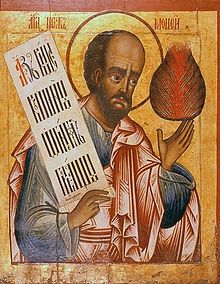 Russian Orthodox icon of the prophet Moses, gesturing towards the burning bush. 18th century (Iconostasis of Transfiguration Church, Kizhi Monastery, Karelia, Russia).
Russian Orthodox icon of the prophet Moses, gesturing towards the burning bush. 18th century (Iconostasis of Transfiguration Church, Kizhi Monastery, Karelia, Russia).
Balak meets with Balaam at Kirjath-huzoth, and they go to the high places of Baal, and offer sacrifices at seven altars, leading to Balaam being given a prophecy by God, which Balaam relates to Balak. However, the prophecy blesses Israel; Balak remonstrates, but Balaam reminds him that he can only speak the words put in his mouth, so Balak takes him to another high place at Pisgah, to try again. Building another seven altars here, and making sacrifices on each, Balaam provides another prophecy blessing Israel. Balaam finally gets taken by a now very frustrated Balak to Peor, and, after the seven sacrifices there, decides not to seek enchantments but instead looks on the Israelites from the peak. The spirit of God comes upon Balaam and he delivers a third positive prophecy concerning Israel. Balak's anger rises to the point where he threatens Balaam, but Balaam merely offers a prediction of fate. Balaam then looks on the Kenites, and Amalekites and offers two more predictions of fate. Balak and Balaam then simply go to their respective homes. Later, Balaam informed Balak and the Midianites that, if they wished to overcome the Israelites for a short interval, they needed to seduce the Israelites to engage in idolatry.[57][non-primary source needed] The Midianites sent beautiful women to the Israelite camp to seduce the young men to partake in idolatry, and the attempt proved successful.[58]
God then commanded Moses to kill and hang the heads of everyone that had engaged in idolatry, and Moses ordered the judges to carry out the mass execution. At the same time, one of the Israelites brought home a Midianitish woman in the sight of the congregation. Upon seeing this, Phinehas, the grandson of Aaron, took a javelin in his hand and thrust through both the Israelite and the Midianitish woman, which turned away the wrath of God. By that time, however, the plague inflicted on the Israelites had already killed about twenty-four thousand persons. Moses was then told that because Phinehas had averted the wrath of God from the Israelites, Phinehas and his descendents were given the pledge of an everlasting priesthood.[59] After Moses had taken a census of the people, he sent an army to avenge the perceived evil brought on the Israelites by the Midianites. Numbers 31 says Moses instructed the Israelite soldiers to kill every Midianite woman, boy, and non-virgin girl, although virgin girls were shared amongst the soldiers.[60] The Israelites killed Balaam, and the five kings of Midian: Evi, Rekem, Zur, Hur, and Reba.[61]
Moses appointed Joshua, son of Nun, to succeed him as the leader of the Israelites.[62] Moses then died at the age of 120.[63]
Death
Moses was warned that he would not be permitted to lead the Israelites across the Jordan river, because of his trespass at the waters of Meribah (Deut. 32:51) but would die on its eastern shores (Num. 20:12).[64] He therefore assembled the tribes, and delivered to them a parting address, which is taken to form the Book of Deuteronomy.[64]
When Moses finished, he sang a song and pronounced a blessing on the people. He then went up Mount Nebo to the top of Pisgah, looked over the promised land of Israel spread out before him, and died, at the age of one hundred and twenty, according to Talmudic legend on 7 Adar, his 120th birthday exactly.[65] God himself buried him in an unknown grave in a valley in the land of Moab, over against Bethpeor (Deut. 34:6).[16][64]
Moses was thus the human instrument in the creation of the nation of Israel by communicating to it the Torah.[64] More humble than any other man (Num. 12:3), he enjoyed unique privileges, for "there hath not arisen a prophet since in Israel like unto Moses, whom YHWH knew face to face" (Deut. 34:10).[64] See also Jude 1:9 and Zechariah 3.
Mosaic law
Further information: Law of Moses, Mosaic authorship, Deuteronomist, Book_of_Deuteronomy#Deuteronomic code, and 613 MitzvotThe Book of Kings relates how a "law of Moses" was discovered in the Temple during the reign of king Josiah (r. 641–609 BC). This book is mostly identified as an early version of the Book of Deuteronomy, perhaps chapters 5-26 and chapter 28 of the extant text. This text contains a number of laws, dated to the 8th century BC kingdom of Judah, a time when a minority Yahwist faction was actively attacking mainstream polytheism, succeeding in establishing official monolatry of the God of Israel under Josiah by the late 7th century BC.
The law attributed to Moses, specifically the laws set out in Deuteronomy, as a consequence came to be considered supreme over all other sources of authority (the king and his officials), and the Levite priests were the guardians and interpreters of the law.[66]
The Book of Deuteronomy (Deuteronomy 31:9 and Deuteronomy 31:24–26) describes how Moses writes "torah" (instruction) on a scroll and lays it beside the ark of the Covenant.[67] Similar passages include, for example, Exodus 17:14, "And YHWH said unto Moses, Write this for a memorial in a book, and rehearse it in the ears of Joshua, that I will utterly blot out the remembrance of Amalek from under heaven;" Exodus 24:4, "And Moses wrote all the words of YHWH, and rose up early in the morning, and built an altar under the mount, and twelve pillars, according to the twelve tribes of Israel;" Exodus 34:27, "And Yahweh said unto Moses, Write thou these words, for after the tenor of these words I have made a covenant with thee and with Israel;"[68] and Leviticus 26:46 "These are the decrees, the laws and the regulations that the LORD established on Mount Sinai between himself and the Israelites through Moses."
Based on this tradition, "Mosaic law" came to refer to the entire legal content of the Pentateuch, not just the Ten Commandments explicitly connected to Moses in the biblical narrative. The content of this law was excerpted and codified in Rabbinical Judaism as the 613 Mitzvot. By Late Antiquity, the tradition of Moses being the source of the law in the Pentateuch also gave rise to the tradition of Mosaic authorship, the interpretation of the entire Torah as the work of Moses.
Moses in Hellenistic literature
Further information: Moses in Judeo-Hellenistic literatureThe Moses Window at the Washington National Cathedral depicts the three stages in Moses' life.
Non-biblical writings about Jews, with references to the role of Moses, first appear at the beginning of the Hellenistic period, the zenith of Greek influence in the ancient world, from 323 BCE to about 146 BCE. Shmuel notes that "a characteristic of this literature is the high honour in which it holds the peoples of the East in general and some specific groups among these peoples."[69]:1102 In addition to the Judeo-Roman or Judeo-Hellenic historians Artapanus, Eupolemus, Josephus, and Philo, a few non-Jewish historians including Hecataeus of Abdera (quoted by Diodorus Siculus), Alexander Polyhistor, Manetho, Apion, Chaeremon of Alexandria, Tacitus and Porphyry also make reference to him. The extent to which any of these accounts rely on earlier sources is unknown.[69]:1103 Moses also appears in other religious texts such as the Mishnah (c. 200 AD), Midrash (AD 200 - 1200),[70] and the Qur'an (c. 610—653).
The figure of Osarseph in Hellenistic historiography is a renegade Egyptian priest who leads an army of lepers against the pharaoh and is finally expelled from Egypt, changing his name to Moses.
- In Hecataeus
The earliest existing reference to Moses in Greek literature occurs in the Egyptian history of Hecataeus of Abdera (4th century BC). All that remains of his description of Moses are two references made by Diodorus Siculus, wherein, writes historian Arthur Droge, "he describes Moses as a wise and courageous leader who left Egypt and colonized Judaea."[71]:18 Among the many accomplishments described by Hecataeus, Moses had founded cities, established a temple and religious cult, and issued laws:
- After the establishment of settled life in Egypt in early times, which took place, according to the mythical account, in the period of the gods and heroes, the first . . . to persuade the multitudes to use written laws was Mneves [Moses], a man not only great of soul but also in his life the most public-spirited of all lawgivers whose names are recorded.[71]:18
Droge also points out that this statement by Hecataeus was similar to statements made subsequently by Eupolemus[71]:18
- In Artapanus
The Jewish historian Artapanus of Alexandria (2nd century BCE), portrayed Moses as a cultural hero, alien to the Pharaonic court. According to theologian John Barclay, the Moses of Artapanus "clearly bears the destiny of the Jews, and in his personal, cultural and military splendor, brings credit to the whole Jewish people."[72]
- Jealousy of Moses' excellent qualities induced Chenephres to send him with unskilled troops on a military expedition to Ethiopia, where he won great victories. After having built the city of Hermopolis, he taught the people the value of the ibis as a protection against the serpents, making the bird the sacred guardian spirit of the city; then he introduced circumcision. After his return to Memphis, Moses taught the people the value of oxen for agriculture, and the consecration of the same by Moses gave rise to the cult of Apis. Finally, after having escaped another plot by killing the assailant sent by the king, Moses fled to Arabia, where he married the daughter of Raguel [Jethro], the ruler of the district." [73]
Artapanus goes on to relate how Moses returns to Egypt with Aaron, and is imprisoned, but miraculously escapes through the name of YHWH in order to lead the Exodus. This account further testifies that all Egyptian temples of Isis thereafter contained a rod, in remembrance of that used for Moses' miracles. He describes Moses as 80 years old, "tall and ruddy, with long white hair, and dignified."
Some historians, however, point out the "apologetic nature of much of Artapanus' work,"[74]:40 with his addition extra-biblical details, as with references to Jethro: The non-Jewish Jethro expresses admiration for Moses' gallantry in helping his daughters, and chooses to adopt Moses as his son.[74]:133
- In Strabo
Strabo, a Greek historian, geographer and philosopher, in his Geography (c. AD 24), wrote in detail about Moses, whom he considered to be an Egyptian who deplored the situation in his homeland, and thereby attracted many followers who respected the deity. He writes, for example, that Moses opposed the picturing of the deity in the form of man or animal, and was convinced that the deity was an entity which encompassed everything – land and sea:[69]:1132
- 35. An Egyptian priest named Moses, who possessed a portion of the country called the Lower Egypt, being dissatisfied with the established institutions there, left it and came to Judaea with a large body of people who worshipped the Divinity. He declared and taught that the Egyptians and Africans entertained erroneous sentiments, in representing the Divinity under the likeness of wild beasts and cattle of the field; that the Greeks also were in error in making images of their gods after the human form. For God [said he] may be this one thing which encompasses us all, land and sea, which we call heaven, or the universe, or the nature of things. . . .
- 36. By such doctrine Moses persuaded a large body of right-minded persons to accompany him to the place where Jerusalem now stands. . . . ''[75]
In Strabo’s writings of the history of Judaism as he understood it, he describes various stages in its development: from the first stage, including Moses and his direct heirs; to the final stage where "the Temple of Jerusalem continued to be surrounded by an aura of sanctity." Strabo’s "positive and unequivocal appreciation of Moses’ personality is among the most sympathetic in all ancient literature." [69]:1133 His portrayal of Moses is said to be similar to the writing of Hecataeus who "described Moses as a man who excelled in wisdom and courage."[69]:1133
Egyptologist Jan Assmann concludes that Strabo was the historian "who came closest to a construction of Moses' religion as monotheism and as a pronounced counter-religion." It recognized "only one divine being whom no image can represent. . . [and] the only way to approach this god is to live in virtue and in justice."[76]:38
- In Tacitus
The Roman historian Tacitus (ca. 56—120 AD) refers to Moses by noting that the Jewish religion was monotheistic and without a clear image. His primary work, wherein he describes Jewish philosophy, is his Histories (ca. 100), where, according to Murphy, as a result of the Jewish worship of one God, "pagan mythology fell into contempt."[77] Tacitus states that, despite various opinions current in his day regarding the Jews' ethnicity, most of his sources are in agreement that there was an Exodus from Egypt. By his account, the Pharaoh Bocchoris, suffering from a plague, banished the Jews in response to an oracle of the god Hammon.
- A motley crowd was thus collected and abandoned in the desert. While all the other outcasts lay idly lamenting, one of them, named Moses, advised them not to look for help to gods or men, since both had deserted them, but to trust rather in themselves, and accept as divine the guidance of the first being, by whose aid they should get out of their present plight.[78]
In this version, Moses and the Jews wander through the desert for only six days, capturing the Holy Land on the seventh.[78]
- In Longinus
The Septuagint, the Greek version of the Hebrew Bible, influenced Longinus, who may have been the author of the great book of literary criticism, On the Sublime, although the true author is still unknown for certain. However, most scholars agree that the author lived in the time of Augustus or Tiberius, the first and second Roman Emperors.
The writer quotes Genesis in a "style which presents the nature of the deity in a manner suitable to his pure and great being," however he does not mention Moses by name, but instead calls him "the Lawgiver of the Jews." Besides its mention of Cicero, Moses is the only non-Greek writer quoted in the work, and he is described "with far more admiration than even Greek writers who treated Moses with respect, such as Hecataeus and Strabo.[69]:1140
- In Josephus
In Josephus' (37 – c. 100 AD) Antiquities of the Jews, Moses is mentioned throughout. For example Book VIII Ch. IV, describes Solomon's Temple, also known as the First Temple, at the time the Ark of the Covenant was first moved into the newly built temple:
When King Solomon had finished these works, these large and beautiful buildings, and had laid up his donations in the temple, and all this in the interval of seven years, and had given a demonstration of his riches and alacrity therein; ... he also wrote to the rulers and elders of the Hebrews, and ordered all the people to gather themselves together to Jerusalem, both to see the temple which he had built, and to remove the ark of God into it; and when this invitation of the whole body of the people to come to Jerusalem was everywhere carried abroad, ... The Feast of Tabernacles happened to fall at the same time, which was kept by the Hebrews as a most holy and most eminent feast. So they carried the ark and the tabernacle which Moses had pitched, and all the vessels that were for ministration to the sacrifices of God, and removed them to the temple... Now the ark contained nothing else but those two tables of stone that preserved the ten commandments, which God spake to Moses in Mount Sinai, and which were engraved upon them...[79]
According to Feldman, Josephus also attaches particular significance to Moses' possession of the "cardinal virtues of wisdom, courage, temperance, and justice." He also includes piety as an added fifth virtue. In addition, he "stresses Moses' willingness to undergo toil and his careful avoidance of bribery. Like Plato's philosopher-king, Moses excels as an educator."[74]:130
- In Numenius
Numenius, a Greek philosopher who was a native of Apamea, in Syria, wrote during the latter half of the 2nd century AD. Historian Kennieth Guthrie writes that "Numenius is perhaps the only recognized Greek philosopher who explicitly studied Moses, the prophets, and the life of Jesus . . . "[80]:194 He describes his background:
Numenius was a man of the world; he was not limited to Greek and Egyptian mysteries, but talked familiarly of the myths of Brahmins and Magi. It is however his knowledge and use of the Hebrew scriptures which distinguished him from other Greek philosophers. He refers to Moses simply as "the prophet", exactly as for him Homer is the poet. Plato is described as a Greek Moses.[80]:101
- In Justin Martyr
The Christian saint and religious philosopher Justin Martyr (103–165 AD) drew the same conclusion as Numenius, according to other experts. Theologian Paul Blackham notes that Justin considered Moses to be "more trustworthy, profound and truthful because he is older than the Greek philosophers."[81] He quotes him:
I will begin, then, with our first prophet and lawgiver, Moses . . . that you may know that, of all your teachers, whether sages, poets, historians, philosophers, or lawgivers, by far the oldest, as the Greek histories show us, was Moses, who was our first religious teacher.[81]
Historicity
The tradition of Moses as a lawgiver and culture hero of the Israelites can be traced to 8th or 7th century BCE in the kingdom of Judah. Moses is a central figure in the Deuteronomist account of the origins of the Israelites, cast in a literary style of elegant flashbacks told by Moses. The Deuteronomist relies on earlier material that may date to the United Monarchy, so that the biblical narrative would be based on traditions that can be traced to about four centuries after the supposed lifetime of Moses.
The question of the historicity of the Exodus (specifically, the Pharaoh of the Exodus, identification of which would connect the biblical narrative to Egyptological chronology) has long been debated, without conclusive result. Many biblical scholars are prepared to admit that there may be a historical core beneath the Exodus and Sinai traditions, even if the biblical narrative dramatizes by portraying as a single event what was more likely a gradual process of migration and conquest. Thus, the motif of "slavery in Egypt" reflects the historical situation of imperialist control of the Egyptian Empire over Canaan after the conquests of Ramesses II, which declined gradually during the 12th century under the pressure from the Sea Peoples and the general Bronze Age collapse[citation needed]. Israel Finkelstein points to the appearance of settlements in the central hill country around 1200 as the earliest of the known settlements of the Israelites.[82] A cyclical pattern to these highland settlements, corresponding to the state of the surrounding cultures, suggests that the local Canaanites combined an agricultural and nomadic lifestyles. When Egyptian rule collapsed after the invasion of the Sea Peoples, the central hill country could no longer sustain a large nomadic population, so they went from nomadism to sedentism.[83][clarification needed]
While the general narrative of the Exodus and the conquest of the Promised Land may be remotely rooted in historical events, the figure of Moses as a leader of the Israelites in these events cannot be substantiated.[84][85][86][87] William Dever agrees with the Canaanite origin of the Israelites but allows for the possibility of some immigrants from Egypt among the early hilltop settlers, leaving open the possibility of a Moses-like figure in Transjordan ca 1250-1200.[88]
Martin Noth holds that two different groups experienced the Exodus and Sinai events, and each group transmitted its own stories independently of the other one, writing that "The biblical story tracing the Hebrews from Egypt to Canaan resulted from an editor's weaving separate themes and traditions around a main character Moses, actually an obscure person from Moab."[89]
William Albright held a more favorable view towards the traditional views regarding Moses, and accept the essence of the biblical story, as narrated between Exodus 1:8 and Deuteronomy 34:12, but recognize the impact that centuries of oral and written transmission have had on the account, causing it to acquire layers of accretions.[89]
Biblical minimalists such as Philip Davies and Niels Peter Lemche regard the Exodus as a fiction composed in the Persian period or even later, without even the memory of a historical Moses.[citation needed]
Moses in religious traditions
Judaism
Main articles: Moses in Hellenistic literature and Moses in Rabbinic LiteratureThere is a wealth of stories and additional information about Moses in the Jewish apocrypha and in the genre of rabbinical exegesis known as Midrash, as well as in the primary works of the Jewish oral law, the Mishnah and the Talmud. Moses is also given a number of bynames in Jewish tradition. The Midrash identifies Moses as one of seven biblical personalities who were called by various names.[90] Moses' other names were: Jekuthiel (by his mother), Heber (by his father), Jered (by Miriam), Avi Zanoah (by Aaron), Avi Gedor (by Kohath), Avi Soco (by his wet-nurse), Shemaiah ben Nethanel (by people of Israel).[91] Moses is also attributed the names Toviah (as a first name), and Levi (as a family name) (Vayikra Rabbah 1:3), Heman,[92] Mechoqeiq (lawgiver)[93] and Ehl Gav Ish (Numbers 12:3)[94]
Jewish historians who lived at Alexandria, such as Eupolemus, attributed to Moses the feat of having taught the Phoenicians their alphabet,[95] similar to legends of Thoth. Artapanus of Alexandria explicitly identified Moses not only with Thoth / Hermes, but also with the Greek figure Musaeus (whom he calls "the teacher of Orpheus"), and ascribed to him the division of Egypt into 36 districts, each with its own liturgy. He names the princess who adopted Moses as Merris, wife of Pharaoh Chenephres.[96]
Ancient sources mention an Assumption of Moses and a Testimony of Moses. A Latin text was found in Milan in the 19th century by Antonio Ceriani who called it the Assumption of Moses, even though it does not refer to an assumption of Moses or contain portions of the Assumption which are cited by ancient authors, and it is apparently actually the Testimony. The incident which the ancient authors cite is also mentioned in the Epistle of Jude.
To Orthodox Jews, Moses is called Moshe Rabbenu, `Eved HaShem, Avi haNeviim zya"a. He is defined "Our Leader Moshe", "Servant of God", and "Father of all the Prophets". In their view, Moses not only received the Torah, but also the revealed (written and oral) and the hidden (the `hokhmat nistar teachings, which gave Judaism the Zohar of the Rashbi, the Torah of the Ari haQadosh and all that is discussed in the Heavenly Yeshiva between the Ramhal and his masters). He is also considered the greatest prophet.[97]
Arising in part from his age, but also because 120 is elsewhere stated as the maximum age for Noah's descendants (one interpretation of Genesis 6:3), "may you live to 120" has become a common blessing among Jews.
Christianity
Prophet Moses 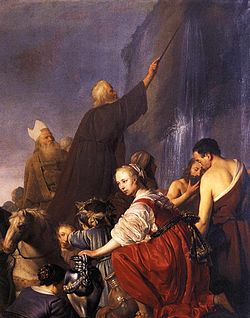
Moses striking the rockProphet, Saint, Seer, Lawgiver, Apostle to Pharoah, Reformer, 'One to Whom God Spoke',[98] 'Our Leader Moses',[99] Leader of the Exodus, Holy Forefather[100] Born Goshen, Lower Egypt Died Mount Nebo, Moab Honored in Judaism
Islam
ChristianityFeast Orthodox Church & Catholic Church: Sept 4 Attributes Tablets of the Law For Christians, Moses — mentioned more often in the New Testament than any other Old Testament figure — is often a symbol of God's law, as reinforced and expounded on in the teachings of Jesus. New Testament writers often compared Jesus' words and deeds with Moses' to explain Jesus' mission. In Acts 7:39–43, 51–53, for example, the rejection of Moses by the Jews that worshiped the golden calf is likened to the rejection of Jesus by the Jews that continued in traditional Judaism.
Moses also figures in several of Jesus' messages. When he met the Pharisees Nicodemus at night in the third chapter of the Gospel of John, he compares Moses' lifting up of the bronze serpent in the wilderness, which any Israelite could look at and be healed, to his own lifting up (by his death and resurrection) for the people to look at and be healed. In the sixth chapter, Jesus responds to the people's claim that Moses provided them manna in the wilderness by saying that it was not Moses, but God, who provided. Calling himself the "bread of life", Jesus states that he is now provided to feed God's people.
He, along with Elijah, is presented as meeting with Jesus in all three Gospel accounts of the Transfiguration of Jesus in Matthew 17, Mark 9, and Luke 9, respectively. Later Christians found numerous other parallels between the life of Moses and Jesus to the extent that Jesus was likened to a "second Moses." For instance, Jesus' escape from the slaughter by Herod in Bethlehem is compared to Moses' escape from Pharaoh's designs to kill Hebrew infants. Such parallels, unlike those mentioned above, are not pointed out in Scripture. See the article on typology.
His relevance to modern Christianity has not diminished. He is considered to be a saint by several churches; and is commemorated as a prophet in the respective Calendars of Saints of the Eastern Orthodox Church, Roman Catholic Church, and Lutheran churches on September 4. He is commemorated as one of the Holy Forefathers in the Calendar of Saints of the Armenian Apostolic Church on July 30.
- Mormonism
Main article: Book of MosesMembers of The Church of Jesus Christ of Latter-day Saints (colloquially called Mormons) generally view Moses in the same way that other Christians do. However, in addition to accepting the Biblical account of Moses, Mormons include Selections from the Book of Moses as part of their scriptural canon.[101] This book is believed to be the translated writings of Moses, and is included in the Pearl of Great Price.[102] Latter-day Saints are also unique in believing that Moses was taken to heaven without having tasted death (translated). In addition, Joseph Smith, Jr. and Oliver Cowdery stated that on April 3, 1836, Moses appeared to them in the Kirtland Temple in a glorified, immortal, physical form and bestowed upon them the "keys of the gathering of Israel from the four parts of the earth, and the leading of the ten tribes from the land of the north."[103]
Islam
Main article: Islamic view of MosesMoses is mentioned more in the Quran than any other individual and his life is narrated and recounted more than that of any other prophet.[104] In general, Moses is described in ways which parallel the prophet Muhammad,[105] and "his character exhibits some of the main themes of Islamic theology," including the "moral injunction that we are to submit ourselves to God."
Moses is defined in the Qur'an as both prophet (nabi) and messenger (rasul), the latter term indicating that he was one of those prophets who brought a scripture and law to his people.
Huston Smith (1991) describes an account in the Qur'an of meetings in heaven between Moses and Muhammad, which Huston states were "one of the crucial events in Muhammad's life," and resulted in Muslims observing 5 daily prayers.[106]
Moses is mentioned 502 times in the Qur'an; passages mentioning Moses include 2.49-61, 7.103-160, 10.75-93, 17.101-104, 20.9-97, 26.10-66, 27.7-14, 28.3-46, 40.23-30, 43.46-55, 44.17-31, and 79.15-25. and many others. Most of the key events in Moses' life which are narrated in the Bible are to be found dispersed through the different Surahs of Qur'an, with a story about meeting Khidr which is not found in the Bible.[104]
In the Moses story related by the Qur'an, Jochebed is commanded by God to place Moses in an ark and cast him on the waters of the Nile, thus abandoning him completely to God's protection.[104][107] Pharaoh's wife Asiya, not his daughter, found Moses floating in the waters of the Nile. She convinced Pharaoh to keep him as their son because they were not blessed with any children.
The Qur'an's account has emphasized Moses' mission to invite the Pharaoh to accept God's divine message[108] as well as give salvation to the Israelites.[104][109] According to the Qur'an, Moses encourages the Israelites to enter Canaan, but they are unwilling to fight the Canaanites, fearing certain defeat. Moses responds by pleading to Allah that he and his brother Aaron be separated from the rebellious Israelites.[110]
According to Islamic tradition, Moses is buried at Maqam El-Nabi Musa, Jericho.
Modern reception
Literature
Thomas Mann's novella The Tables of the Law is a retelling of the story of the exodus from Egypt, with Moses as its main character.
- In Freudian psychoanalysis
Freud, in his last book, Moses and Monotheism in 1939, postulated that Moses was an Egyptian nobleman who adhered to the monotheism of Akhenaten. Following a theory proposed by a contemporary biblical critic, Freud believed that Moses was murdered in the wilderness, producing a collective sense of patricidal guilt that has been at the heart of Judaism ever since. "Judaism had been a religion of the father, Christianity became a religion of the son", he wrote. The possible Egyptian origin of Moses and of his message has received significant scholarly attention.[76]
Opponents of this view observe that the religion of the Torah seems different to Atenism in everything except the central feature of devotion to a single god,[111] although this has been countered by a variety of arguments, e.g. pointing out the similarities between the Hymn to Aten and Psalm 104.[112][113] Freud's interpretation of the historical Moses is not well accepted among historians, and is considered pseudohistory by most.[114]
- Criticism
Main article: Criticism of MosesIn the late 18th century the deist Thomas Paine commented at length on Moses' Laws in The Age of Reason, and gave his view that "the character of Moses, as stated in the Bible, is the most horrid that can be imagined",[115] giving the story at Numbers 31:13-18 as an example. In the 19th century the agnostic Robert G. Ingersoll wrote "...that all the ignorant, infamous, heartless, hideous things recorded in the 'inspired' Pentateuch are not the words of God, but simply 'Some Mistakes of Moses'".[116] In the 2000s, the atheist Richard Dawkins referring, like Paine, to the incident at Numbers 31:13-18, concluded, "No, Moses was not a great role model for modern moralists."[117]
Figurative art
Moses is depicted in several U.S. government buildings because of his legacy as a lawgiver. In the Library of Congress stands a large statue of Moses alongside a statue of the Apostle Paul. Moses is one of the 23 lawgivers depicted in marble bas-reliefs in the chamber of the U.S. House of Representatives in the United States Capitol. The other twenty-two figures have their profiles turned to Moses, which is the only forward-facing bas-relief.[118][119]
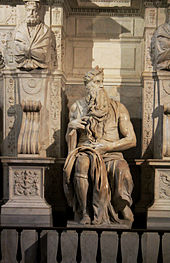 Statue by Michelangelo — in Basilica San Pietro in Vincoli, Rome
Statue by Michelangelo — in Basilica San Pietro in Vincoli, Rome
Moses appears eight times in carvings that ring the Supreme Court Great Hall ceiling. His face is presented along with other ancient figures such as Solomon, the Greek god Zeus and the Roman goddess of wisdom, Minerva. The Supreme Court building's east pediment depicts Moses holding two tablets. Tablets representing the Ten Commandments can be found carved in the oak courtroom doors, on the support frame of the courtroom's bronze gates and in the library woodwork. A controversial image is one that sits directly above the chief justice's head. In the center of the 40-foot-long Spanish marble carving is a tablet displaying Roman numerals I through X, with some numbers partially hidden.[120]
Michelangelo's statue
Michelangelo's statue of Moses in the Church of San Pietro in Vincoli, Rome, is one of the most familiar masterpieces in the world. Horns the sculptor included on Moses' head are the result of a mistranslation of the Hebrew Bible into the Latin Vulgate Bible with which he was familiar. The Hebrew word taken from Exodus means either a "horn" or an "irradiation." Experts at the Archaeological Institute of America show that the term was used when Moses "returned to his people after seeing as much of the Glory of the Lord as human eye could stand," and his face "reflected radiance."[121] In early Jewish art, moreover, Moses is often "shown with rays coming out of his head."[122]
Another author explains, "When Saint Jerome translated the Old Testament into Latin, he thought no one but Christ should glow with rays of light — so he advanced the secondary translation.[123][124] However, writer J. Stephen Lang points out that Jerome's version actually described Moses as "giving off hornlike rays," and he "rather clumsily translated it to mean 'having horns.'"[125] It has also been noted that he had Moses seated on a throne, yet Moses was neither a King nor ever sat on such thrones.[126]
Film and television
Moses was portrayed by Theodore Roberts in DeMille's 1923 silent film The Ten Commandments. Moses appears as the central character in the 1956 Cecil B. DeMille movie, also called The Ten Commandments. He is portrayed by Charlton Heston. A television remake was produced in 2006.
Burt Lancaster played Moses in the 1975 television miniseries Moses the Lawgiver In the 1981 film History of the World, Part I, Moses is portrayed by Mel Brooks.[127] Sir Ben Kingsley portrayed Moses in the movie of the same name.
Moses appears as the central character in the 1998 DreamWorks Pictures animated movie, The Prince of Egypt. He is voiced by Val Kilmer.[128]
See also
Notes
- ^ Deuteronomy 34:10
- ^ Maimonides, 13 principles of faith, 7th principle
- ^ Princeton University Press Press Reviews, retrieved 6th June 2009
- ^ The Quest for the Historical Israel: Debating Archeology and the History of Early Israel, 2007, Society of Biblical Literature, Atlanta, ISBN 978-1-58983-277-0.
- ^ John Van Seters, "The life of Moses", ISBN 903900112X
- ^ Seder Olam Rabbah[Full citation needed]
- ^ Jerome's Chronicon (4th century) gives 1592 for the birth of Moses,[citation needed] the 17th-century Ussher chronology calculates 1619 BC (Annals of the World, 1658)
- ^ a b New World Dictionary-Concordance to the New American Bible. World Publishing. 1970. p. 461. ISBN 0-529-04540-0.
- ^ HAW Theological Wordbook of the Old Testament
- ^ Lambdin, T.O., Intro. to Biblical Hebrew. NY:Charles Scribner's Sons, 1971. pp. 18-19
- ^ Gesenius' Lexicon (1906), s.v. מֹשֶׁה ; Gesenius was sympathetic towards the Coptic etymology. So also Jones' Dictionary of Old Testament Proper Names
- ^ So BDB Theological Dictionary and HAW Theological Wordbook of the Old Testament; see "Meaning, origin and etymology of the name Moses". http://www.abarim-publications.com/Meaning/Moses.html.
- ^ a b c d e Easton, Matthew George (1897). Illustrated Bible Dictionary. London ; New York: T. Nelson. ISBN 1157582583. "Moses".
- ^ Genesis 46
- ^ a b c d e f g h "Biblical data on Moses". http://jewishencyclopedia.com/view.jsp?artid=830&letter=M&search=moses#0.
- ^ a b "Moses". Catholic Encyclopedia. New York: Robert Appleton Company. 1913. http://www.newadvent.org/cathen/10596a.htm.
- ^ "Antiquities of the Jews, Book II, Chapter 9, Paragraph 5". http://www.nalanda.nitc.ac.in/resources/english/etext-project/history/antiqjews/book-2chapter9.html.
- ^ "Antiquities of the Jews, Book II, Chapter 8, Paragraph 7". http://www.gutenberg.org/catalog/world/readfile?fk_files=2359&pageno=61.
- ^ Flavius Josephus does not mention this incident in his account, so it is uncertain as to its chronological relationship to Moses' expedition against the Ethiopians.
- ^ "Antiquities of the Jews, Book II, Chapter 11, Paragraph 2". http://www.gutenberg.org/catalog/world/readfile?fk_files=2359&pageno=63.
- ^ No further mention is made of Moses' first wife Tharbis in either Exodus or Flavius Josephus except in the case where Aaron and Miriam taunted Moses about it.
- ^ "Exodus 2:16–22". http://www.biblegateway.com/passage/?search=Exodus%202:16-22;&version=9;.
- ^ "Exodus 4:2–9". http://www.biblegateway.com/passage/?search=Exodus%204:2-9;&version=9;.
- ^ "Exodus 4:20–31". http://www.biblegateway.com/passage/?search=Exodus%204:20-31;&version=9;.
- ^ "Exodus 8:13-15". http://www.biblegateway.com/passage/?search=Exodus%208:13-15;&version=9;.
- ^ "Judaism 101: Pesach; Passover". http://www.jewfaq.org/holidaya.htm.
- ^ "The Yam Suph: "Red Sea" or "Sea of Reeds"". Cresourcei.org. 2006-07-20. http://www.cresourcei.org/yamsuph.html. Retrieved 2010-03-02.
- ^ Shore
- ^ Elim and Elat are plurals of the word El in Phoenician and again associated with Asherah worship. The words Elim and Elat refer to the power of the high and mighty terebinth trees that the Phoenicians used for masts and Asherah poles. William Albright has associated Asherah groves with the incense trade spices and perfumes such as frankincense and myrrh.
- ^ Exodus 32:19
- ^ Exodus 32:27
- ^ Exodus 32:28
- ^ Exodus 34:1, 34:27–28
- ^ "Exodus 15:23–25". http://www.biblegateway.com/passage/?search=Exodus%2015:23-25;&version=9;.
- ^ Chaim Dovid Green. "Project Genesis: Parshas B'Shalach — Rough Beginnings". http://www.torah.org/learning/dvartorah/5761/beshalach.html. Retrieved 2008-07-16.
- ^ "Ex. 16". http://www.biblegateway.com/passage/?search=Exodus%2016;&version=9;.
- ^ Eliyahu Hoffmann. "Project Genesis: Parshas Beshalach — Man or Mon?". http://www.torah.org/learning/olas-shabbos/5766/beshalach.html. Retrieved 2008-07-16.
- ^ "Ex. 17:1–7". http://www.biblegateway.com/passage/?search=Exodus%2017:1-7;&version=9;.
- ^ Pinchas Avruch. "Project Genesis: Parshas Beshalach — Never Forget". http://www.torah.org/learning/kolhakollel/5765/beshalach.html. Retrieved 2008-07-16.
- ^ "Ex. 17:8–13". http://www.biblegateway.com/passage/?search=Exodus%2017:8-13;&version=9;.
- ^ Dovid Rosenfeld. "Project Genesis: Pirkei Avos – Exhilarating Fear". http://www.torah.org/learning/pirkei-avos/chapter6-65-8.html. Retrieved 2008-07-16.
- ^ "Ex. 18". http://www.biblegateway.com/passage/?book_id=2&chapter=18&version=9.
- ^ "Exodus 32". http://www.biblegateway.com/passage/?search=Exodus%2032%20;&version=9;.
- ^ Mordechai Kamenetzky. "Project Genesis: Parshas Ki Sisa — Masked Emotions". http://www.torah.org/learning/drasha/5758/kisisa.html. Retrieved 2008-07-16.
- ^ "The Tabernacle of Israel; Court". http://www.glencairnmuseum.org/tabernacle/court.htm.
- ^ "Antiquities of the Jews page 61". http://www.gutenberg.org/catalog/world/readfile?pageno=61&fk_files=2359.
- ^ "Numbers 12:1–15". http://www.biblegateway.com/passage/?search=Numbers%2012:1-15;&version=9;.
- ^ "Numbers 12:16". http://www.biblegateway.com/passage/?search=Numbers%2012:16;&version=9;.
- ^ "Numbers 13–14". http://www.biblegateway.com/passage/?search=Numbers%2013-14;&version=9;.
- ^ "Numbers 16". http://www.biblegateway.com/passage/?book_id=4&chapter=16&version=9.
- ^ "Numbers 17:1–8". http://www.biblegateway.com/passage/?search=Numbers%2017:1-8;&version=9;.
- ^ "Num. 20:1–13". http://www.biblegateway.com/passage/?search=Numbers%2020:1-13;&version=9;.
- ^ "Num. 21:4–9". http://www.biblegateway.com/passage/?search=Numbers%2021:4-9;&version=31;.
- ^ "2 Kings 18:1–4". http://www.biblegateway.com/passage/?search=2%20Kings%2018:1-4;&version=31;.
- ^ a b Tromp, Johnannes (1993). The Assumption of Moses: A Critical Edition with Commentary. Brill. ISBN 9004097791.
- ^ "The Story of Balaam". http://www.thenazareneway.com/story_of_balaam.htm.
- ^ "Antiquities of the Jews, Book IV, Chapter VI, Paragraph 6". http://www.gutenberg.org/catalog/world/readfile?fk_files=2359&pageno=114.
- ^ Deuteronomy 23:3–6 summarises these incidents, and further states that the Ammonites were associated with the Moabites. Joshua, in his farewell speech, also makes reference to it. Nehemiah, Micah, and Joshua continue in the historical account of Balaam, who next advises the Midianites how to bring disaster on the Israelites by seducing the people with idols and beautiful women, which proves partly successful.
- ^ "Num. 25:1–13". http://www.biblegateway.com/passage/?search=Numbers%2025:1-13;&version=9;.
- ^ "Num. 31:17-18". http://www.biblegateway.com/passage/?search=numbers%2031;&version=50;.
- ^ "Num. 31:8". http://www.biblegateway.com/passage/?search=Numbers%2031:8;&version=9;.
- ^ "Num. 27:15–23". http://www.biblegateway.com/passage/?search=Numbers%2027:15-23;&version=9;.
- ^ Deuteronomy 34 7
- ^ a b c d e "Death of Moses". http://jewishencyclopedia.com/view.jsp?artid=830&letter=M&search=moses#2846.
- ^ Talmud Bavli, Megilah 13b, Sotah 12b, Kidushin 38a, Beshallaḥ, Wayassa', 5 [ed. Weiss, p. 60a]; comp. Josephus, l.c. iv. 8, § 49. According to the Seder Olam in the year 2488 (corresponding to ca. Feb-Mar 1271 BCE; Seder Olam's calendar starts two years later than the one currently used by Jews.)[citation needed]
- ^ Graham, M.P, and McKenzie, Steven L., "The Hebrew Bible today: an introduction to critical issues" (Westminster John Knox Press, 1998) p.19ff
- ^ Deuteronomy.
- ^ Exodus
- ^ a b c d e f Shmuel, Safrai, M. Stern (ed) The Jewish People in the First Century, Van Gorcum Fortress Press (1976)
- ^ Hammer, Reuven. The Classic Midrash: Tannaitic Commentaries on the Bible, Paulist Press (1995) p. 15
- ^ a b c Droge, Arthur J. Homer or Moses?: Early Christian Interpretations of the History of Culture, Mohr Siebeck (1989)
- ^ Barclay, John M. G. Jews in the Mediterranean diaspora: from Alexander to Trajan (323 BCE - 117 CE), University of California Press (1996) p. 130
- ^ "Moses". JewishEncyclopedia.com. http://jewishencyclopedia.com/view.jsp?artid=830&letter=M&search=moses#3. Retrieved 2010-03-02.
- ^ a b c Feldman, Louis H. Josephus's Interpretation of the Bible, University of California Press (1998)
- ^ Strabo. The Geography of Strabo, XVI 35, 36, Translated by H.C. Hamilton and W. Falconer, pp. 177-178,
- ^ a b Assmann, Jan (1997). Moses the Egyptian: The Memory of Egypt in Western Monotheism. Harvard University Press. ISBN 0-674-58738-3. See also Y. Yerushalmi's monograph on Freud's Moses.
- ^ Tacitus, Cornelius. The works of Cornelius Tacitus: With an essay on his life and genius by Arthur Murphy, Thomas Wardle Publ. (1842) p. 499
- ^ a b Tacitus, Cornelius. Tacitus, The Histories, Volume 2, Book V. Chapters 5, 6 p. 208.
- ^ Josephus, Flavius. The works of Flavius Josephus: Comprising the Antiquities of the Jews, trans. by William Whiston, (1854) Book VIII, Ch. IV, pp. 254-255
- ^ a b Guthrie, Kenneth Sylvan. Numenius of Apamea: The Father of Neo-Platonism, George Bell & Sons (1917)
- ^ a b Blackham, Paul; ed. Paul Louis Metzger. Trinitarian Soundings in Systematic Theology, in essay: "The Trinity in the Hebrew Scriptures", Continuum International Publ. Group (2005) p. 39
- ^ I Finkelstein and N. Na'aman, eds., From Nomadism to Monarchy (Jerusalem: Israel Exploration Society, 1994)
- ^ Finkelstein, Israel and Silberman, Neil Asher (2001). The Bible Unearthed. New York: Free Press. ISBN 0-684-86912-8.
- ^ Who Were the Early Israelites? by William G. Dever (William B. Eerdmans Publishing, Grand Rapids, MI, 2003)
- ^ The Bible Unearthed by Neil Asher Silberman and Israel Finkelstein (Simon and Schuster, New York, 2001)
- ^ "''False Testament''by Daniel Lazare (Harper's Magazine, New York, May 2002)". Harpers.org. http://harpers.org/archive/2002/03/0079105. Retrieved 2010-10-11.
- ^ "Archaeology and the Hebrew Scriptures". http://www.religioustolerance.org/chr_arhs.htm.
- ^ Dever, William G. (2002). What Did the Biblical Writers Know and When Did They Know It?. Wm. B. Eerdmans Publishing Company. ISBN 0-8028-2126-X.
- ^ a b "Moses." Encyclopædia Britannica. 2007. Encyclopædia Britannica Online
- ^ Midrash Rabbah, Ki Thissa, XL. 3-3, Lehrman, P.463
- ^ Yalkut Shimoni, Shemot 166 to Chronicles I 4:18, 24:6; also see Vayikra Rabbah 1:3; Chasidah p.345
- ^ Rashi to Bava Batra 15s, Chasidah p.345
- ^ Bava Batra 15a on Deuteronomy 33:21, Chasidah p.345
- ^ Rashi to Berachot 54a), Chasidah p.345
- ^ Eusebius, Præparatio Evangelica ix. 26
- ^ Eusebius, l.c. ix. 27
- ^ "Judaism 101: Moses, Aaron and Miriam". Jewfaq.org. http://www.jewfaq.org/moshe.htm. Retrieved 2010-03-02.
- ^ This title is held specifically in Islam.
- ^ This is a specifically Jewish title
- ^ Moses is commemorated as a forefather, along with the patriarchs, in the Armenian Apostolic Church
- ^ "About Mormons". About Mormons. http://www.aboutmormons.com/bom.php. Retrieved 2010-03-02.
- ^ "The Book of Moses". Lightplanet.com. http://www.lightplanet.com/mormons/basic/scripture/moses.html. Retrieved 2010-03-02.
- ^ The Doctrine and Covenants 110:11
- ^ a b c d Annabel Keeler, "Moses from a Muslim Perspective", in: Solomon, Norman; Harries, Richard; Winter, Tim (eds.), Abraham's children: Jews, Christians, and Muslims in conversation, by . T&T Clark Publ. (2005), pp. 55 - 66.
- ^ Keeler (2005) describes Moses from the Muslim perspective:
- ”Among prophets, Moses has been described as the one ‘whose career as a messenger of God, lawgiver and leader of his community most closely parallels and foreshadows that of Muhammad’, and as ‘the figure that in the Koran was presented to Muhammad above all others as the supreme model of saviour and ruler of a community, the man chosen to present both knowledge of the one God, and a divinely revealed system of law’. We find him clearly in this role of Muhammad’s forebear in a well-known tradition of the miraculous ascension of the Prophet, where Moses advises Muhammad from his own experience as messenger and lawgiver.”
- ^ Smith, Huston. The world's religions HarperCollins, (1991) p. 245
- ^ Quran 28:7
- ^ Quran 79:17–19
- ^ Quran 20:47–48
- ^ Quran 5:20
- ^ "Order of the Aten Temple". http://www.atenism.org/.
- ^ Jan Assmann, op. cit.
- ^ Atwell, James E. (2000). "An Egyptian Source for Genesis 1". Journal of Theological Studies 51 (2): 441–477. doi:10.1093/jts/51.2.441.
- ^ Bernstein, Richard J. (1998). Freud and the Legacy of Moses. New York: Cambridge University Press. ISBN 0521630967.
- ^ Thomas Paine The Age of Reason part II, 1796
- ^ Robert G. Ingersoll, Some Mistakes of Moses chapter XXIX
- ^ Richard Dawkins, The God Delusion, 2006, chapter 7
- ^ "Relief Portraits of Lawgivers: Moses. Architect of the Capitol". Aoc.gov. 2009-02-13. http://www.aoc.gov/cc/art/lawgivers/moses.cfm. Retrieved 2010-03-02.
- ^ "Courtroom Friezes: North and South Walls: Information Sheet." Supreme Court of the United States. [1]
- ^ "In the Supreme Court itself, Moses and his law on display" Religion News Service
- ^ MacLean, Margaret. (ed) Art and Archaeology, Vol. VI, Archaeological Institute of America (1917) p. 97
- ^ Devore, Gary M. (2008). Walking Tours of Ancient Rome: A Secular Guidebook to the Eternal City. Mercury Guides. p. 126. ISBN 9780615194974.
- ^ Thomason, Dustin; Caldwell, Ian (2005). The Rule of Four. New York: Random House. p. 151. ISBN 0440241359.
- ^ Gross, Kenneth (2005). The Dream of the Moving Statue. Ithaca, NY: Cornell Univ. Press. p. 245. ISBN 0271029005.
- ^ Lang, J. Stephen (2003). What the Good Book Didn't Say: Popular Myths and Misconceptions About the Bible. New York: Citadel Press. p. 114. ISBN 080652460X.
- ^ Boitani, Piero (1999). The Bible and its Rewritings. Oxford: Oxford Univ. Press. p. 126. ISBN 0198184875.
- ^ "History of the World: Part I". http://www.imdb.com/title/tt0082517/.
- ^ "Prince of Egypt". http://imdb.com/title/tt0120794/.
Further reading
- Asch, Sholem. Moses. New York: Putnam, 1958. ISBN 0742691373.
- Assmann, Jan. Moses the Egyptian: The Memory of Egypt in Western Monotheism. Harvard University Press, 1997. ISBN 0-674-58738-3.
- Barenboim, Peter. Biblical Roots of Separation of Power, Moscow : Letny Sad, 2005, ISBN 5943811230, http://lccn.loc.gov/2006400578
- Barzel, Hillel. "Moses: Tragedy and Sublimity." In Literary Interpretations of Biblical Narratives. Edited by Kenneth R.R. Gros Louis, with James S. Ackerman & Thayer S. Warshaw, 120–40. Nashville: Abingdon Press, 1974. ISBN 0-687-22131-5.
- Buber, Martin. Moses: The Revelation and the Covenant. New York: Harper, 1958.
- Card, Orson Scott. Stone Tables. Deseret Book Co., 1998. ISBN 1-57345-115-0.
- Chasidah, Yishai. "Moses." In Encyclopedia of Biblical Personalities: Anthologized from the Talmud, Midrash and Rabbinic Writings, 340–99. Brooklyn: Shaar Press, 1994.
- Cohen, Joel. Moses: A Memoir. Mahwah, N.J.: Paulist Press, 2003. ISBN 0-8091-0558-6.
- Daiches, David. Moses: The Man and his Vision. New York: Praeger, 1975. ISBN 0-275-33740-5.
- Fast, Howard. Moses, Prince of Egypt. New York: Crown Pubs., 1958.
- Freud, Sigmund. Moses and Monotheism. New York: Vintage, 1967. ISBN 0-394-70014-7.
- Gjerman, Corey. Moses: The Father I Never Knew. Portland: Biblical Fantasticals, 2007. ISBN 978-1424171132.
- Halter, Marek. Zipporah, Wife of Moses. New York: Crown, 2005. ISBN 1400052793.
- Hoffmeier, James K. 'Moses and the Exodus.' In: Israel in Egypt: The Evidence for the Authenticity of the Exodus Tradition, pp. 135–63. New York: Oxford University Press, 1996.
- Ingraham, J. H.. The Pillar of Fire: Or Israel in Bondage. New York: A.L. Burt, 1859. Reprinted Ann Arbor, Mich.: Scholarly Publishing Office, University of Michigan Library, 2006. ISBN 1425564917.
- Kirsch, Jonathan. Moses: A Life. New York: Ballantine, 1998. ISBN 0-345-41269-9.
- Kohn, Rebecca. Seven Days to the Sea: An Epic Novel of the Exodus. New York: Rugged Land, 2006. ISBN 1-59071-049-5.
- Lehman, S.M. (translator), Freedman, H. (ed.), Midrash Rabbah, 10 volumes, The Soncino Press, London, 1983.
- Mann, Thomas. "Thou Shalt Have No Other Gods Before Me." In The Ten Commandments, 3–70. New York: Simon & Schuster, 1943.
- Salibi, Kamal. The Bible Came from Arabia. London: Jonathan Cape, 1985.
- Sandmel, Samuel. Alone Atop the Mountain. Garden City, N.Y.: Doubleday, 1973. ISBN 0-385-03877-1.
- Southon, Arthur E. On Eagles' Wings. London: Cassell and Co., 1937. Reprinted New York: McGraw-Hill, 1954.
- Wiesel, Elie. “Moses: Portrait of a Leader.” In Messengers of God: Biblical Portraits & Legends, 174–210. New York: Random House, 1976. ISBN 0-394-49740-6.
- Wildavsky, Aaron. Moses as Political Leader. Jerusalem: Shalem Press, 2005. ISBN 965-7052-31-9.
- Wilson, Dorothy Clarke. Prince of Egypt. Philadelphia: Westminster Press, 1949.
- Van Seters, John: Life of Moses
- K. van der Toorn, Bob Becking, Pieter Willem van der Horst: Dictionary of deities and demons in the Bible
External links
This article incorporates text from the 1901–1906 Jewish Encyclopedia article "Moses", a publication now in the public domain.
- The Geography, Book XVI, Chapter II The entire context of the cited chapter of Strabo's work
MosesPreceded by
NALawgiver Succeeded by
JoshuaProphets in the Hebrew Bible Pre-Patriarchs (Bible) Patriarchs and Matriarchs Israelite prophets
in the TorahProphets mentioned
in the Former ProphetsMajor Prophets Minor Prophets Noahide prophets Other prophets Italics denote that the status as a prophet is not universally accepted. · rl are articles dealing with the prophet within Rabbinic Literature. Prophets in the Qur'an Note: Muslims believe that there were many prophets sent by God to mankind. The Islamic prophets above are only the ones mentioned by name in the Qur'an. Categories:- Prophets of the Hebrew Bible
- Moses
- 15th-century BC biblical rulers
- Biblical murderers
- Book of Exodus
- Old Testament saints
- People celebrated in the Lutheran liturgical calendar
- Prophets of Islam
- Torah people
Wikimedia Foundation. 2010.

